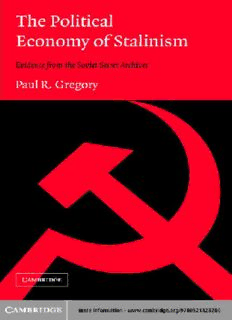
The Political Economy of Stalinism: Evidence from the Soviet Secret Archives PDF
Preview The Political Economy of Stalinism: Evidence from the Soviet Secret Archives
P1:FCH/FFX P2:FCH/FFX QC:FCH/FFX T1:FCH CB575-FM CB575-Gregory-v1 July31,2003 9:53 This page intentionally left blank ii P1:FCH/FFX P2:FCH/FFX QC:FCH/FFX T1:FCH CB575-FM CB575-Gregory-v1 July31,2003 9:53 ThePoliticalEconomyofStalinism EvidencefromtheSovietSecretArchives This book uses the formerly secret Soviet State and Communist Party archives to describe the creation and operations of the Soviet administrative-commandsystem.Itconcludesthatthesystemfailednot becauseofthe“jockey”(i.e.,Stalinandlaterleaders)butbecauseofthe “horse”(theeconomicsystem).AlthoughStalinwasthesystem’sprime architect,thesystemwasmanagedbythousandsof“Stalins”inanested dictatorship.ThecorevaluesoftheBolshevikPartydictatedthechoice oftheadministrative-commandsystem,andthesystemdictatedthepo- litical victory of a Stalin-like figure. This study pinpoints the reasons for the failure of the system – poor planning, unreliable supplies, the preferentialtreatmentofindigenousenterprises,thelackofknowledge ofplanners,etc.–butalsofocusesonthebasicprincipal–agentconflict between planners and producers, which created a sixty-year reform stalemate.OnceGorbachevgaveenterprisestheirfreedom,thesystem had no direction from either a plan or a market, and the system im- ploded. The Soviet administrative-command system was arguably the mostsignificanthumanexperimentofthetwentiethcentury.Ifrepeated today,itsbasiccontradictionsandinherentflawswouldremain,andits economicresultswouldagainproveinferior. Paul R. Gregory is Cullen Professor of Economics at the University of Houston and currently serves as a Research Fellow at the Hoover Institution, Stanford University. He is also a research professor at the German Institute for Economic Research (DIW) in Berlin. Professor Gregory has published widely in the field of Russian and Soviet eco- nomicsformorethanthirtyyearsandservedasavisitingprofessorat MoscowStateUniversity.AmonghisnumerousbooksareRestructur- ing the Soviet Economic Bureaucracy (1990), Before Command: The Russian Economy from Emancipation to Stalin (1994), and Russian NationalIncome,1885–1913.Heistheco-author(withRobertStuart) of Russian and Soviet Economic Structure and Performance, now in itsseventhedition.ProfessorGregoryreceivedhisPh.D.ineconomics fromHarvardin1969. i P1:FCH/FFX P2:FCH/FFX QC:FCH/FFX T1:FCH CB575-FM CB575-Gregory-v1 July31,2003 9:53 ii P1:FCH/FFX P2:FCH/FFX QC:FCH/FFX T1:FCH CB575-FM CB575-Gregory-v1 July31,2003 9:53 The Political Economy of Stalinism Evidence from the Soviet Secret Archives PAUL R. GREGORY UniversityofHouston HooverInstitution iii Cambridge, New York, Melbourne, Madrid, Cape Town, Singapore, São Paulo Cambridge University Press The Edinburgh Building, Cambridge , United Kingdom Published in the United States of America by Cambridge University Press, New York www.cambridge.org Information on this title: www.cambridge.org/9780521826280 © Paul R. Gregory 2004 This book is in copyright. Subject to statutory exception and to the provision of relevant collective licensing agreements, no reproduction of any part may take place without the written permission of Cambridge University Press. First published in print format 2003 - isbn-13 978-0-511-07103-4 eBook (EBL) - isbn-10 0-511-07103-5 eBook (EBL) - isbn-13 978-0-521-82628-0 hardback - isbn-10 0-521-82628-4 hardback isbn--13 978-0-521-53367-6 paperback - isbn-10 0-521-53367-8 paperback Cambridge University Press has no responsibility for the persistence or accuracy of s for external or third-party internet websites referred to in this book, and does not guarantee that any content on such websites is, or will remain, accurate or appropriate. P1:FCH/FFX P2:FCH/FFX QC:FCH/FFX T1:FCH CB575-FM CB575-Gregory-v1 July31,2003 9:53 Contents Illustrations pagevi Tables vii Preface ix 1 TheJockeyortheHorse? 1 2 Collectivization,Accumulation,andPower 22 3 ThePrinciplesofGovernance 49 4 Investment,Wages,andFairness 76 5 VisionsandControlFigures 110 6 PlannersVersusProducers 126 7 CreatingSovietIndustry 153 8 OperationalPlanning 183 9 RubleControl:Money,Prices,andBudgets 213 10 TheDestructionoftheSovietAdministrative-Command Economy 243 11 Conclusions 268 AppendixA:ArchivalSources 273 AppendixB:TheStructureoftheState 275 Bibliography 289 Index 301 v P1:FCH/FFX P2:FCH/FFX QC:FCH/FFX T1:FCH CB575-FM CB575-Gregory-v1 July31,2003 9:53 Illustrations Fig.2.1 Sovietgrain-procurementcrisis 35 Fig.2.2 Marketsvs.coercion 36 Fig.2.3 Sovietgrainproductionandprocurement 39 Fig.4.1 Choiceofmaximuminvestment 87 Fig.4.2 Dynamicsofanincreaseincapitalthrough investment 88 Fig.4.3 Dynamicsofanincreaseinthefairwage 90 Fig.4.4 Nominalandreal(1932prices)investment,USSR, 1928–1938 92 Fig.4.5 Annualgrowthrates,1929–1937,nominal investmentandlaborproductivity 96 Fig.4.6 Stakhanovism 104 Fig.6.1 CentralSovietadministration 130 Fig.6.2 Verticalvs.horizontalstructures 134 Fig.9.1 Verticalvs.horizontaltransactions 216 Fig.9.2 Monetaryaggregates,1932–1936(onJanuary1of eachyear) 225 Fig.9.3 Interenterprisearrears,1933–1939(monthly, millionsofrubles) 230 Fig.9.4 Annualgrowthratesofmoneyand investmentgoodsprices,1929–1938 240 Fig.10.1 SovietGDPgrowthincomparativeperspective 244 Fig.10.2 ComparativegrowthofSovietcapitalstock 244 Fig.10.3 Industrialoutput,industrialcapital,and capitalproductivity,USSR 250 Fig.10.4 Relativegrowthratesofconsumptionand investment 260 vi P1:FCH/FFX P2:FCH/FFX QC:FCH/FFX T1:FCH CB575-FM CB575-Gregory-v1 July31,2003 9:53 Tables Table2.1 Output,StatePurchase,andPricesofGrain 33 Table2.2 MassPeasants’Demonstration,1930a (inUSSRTerritory) 42 Table3.1 PolitburoMeetings,1930–1936 70 Table3.2 NumberofIssuesDiscussedatPolitburo Meetings,1930–1940 71 Table3.3 MeetingsofPolitburoMemberswith Stalin,1931–1939 73 Table4.1 SecondFive-YearPlanInvestmentGoals, 1933–1937,byCommissariat(MillionRubles, 1933PlanPrices) 78 Table4.2 AlternateInvestmentPlanDrafts,1935and1936 (MillionRubles) 82 Table5.1 TargetsfortheFifthFive-YearPlan 117 Table5.2 MeanAbsoluteDeviationfrom100%Plan Fulfillment(AnnualPlanvs.Five-YearPlan) 119 Table6.1 FirstQuarter1932Plans,Cars 148 Table7.1 SimplifiedMaterialBalance 157 Table8.1 StagesofAnnualPlanning:Government andMinistries 192 Table8.2 StagesofEnterprisePlans 193 Table8.3 PlanningPhasesforthe1934AnnualPlan, MinistryofHeavyIndustry,for1933 194 Table8.4 MeetingsofMinistryCollegiumsofNKTPand NKLPtoDiscusstheAnnualPlan 198 Table9.1 DistributionofGosbankCredits,1933–1936 (Percentages) 227 vii P1:FCH/FFX P2:FCH/FFX QC:FCH/FFX T1:FCH CB575-FM CB575-Gregory-v1 July31,2003 9:53 viii Tables Table9.2 EnterprisesCredits:Commercialvs.Gosbank (RankOrderings) 228 Table9.3 StateBudget,SecondFive-YearPlan,1933–1937 (BillionRubles) 238 Tableb.1 StaffofNKTP,1930s 276 Tableb.2a NKLPStaff,FirstHalfYear–1933 277 Tableb.2b WageBillofNKLP,FirstHalfof1933(Rubles) 278 Tableb.3 TheStaffandStructureofGump,March1937 280 Tableb.4 Gump’sEmployeesandTheirDistributionby Profession,March1937 281 Tableb.5a StaffofLeatherFootwearAdministrationof NKLP,1935–1939 282 Tableb.5b StaffofLeatherFootwearAdministrationby BranchandFunctionalDivisions 282 Tableb.6a StaffofKnittingIndustryGlavk,1935–1939 283 Tableb.6b StaffofKnittingAdministrationbyBranchand FunctionalDivisions 283 Tableb.7 ScheduleofStaffDownsizinginPeople’s CommissariatandCentralEstablishmentsofUSSR 284
Description: